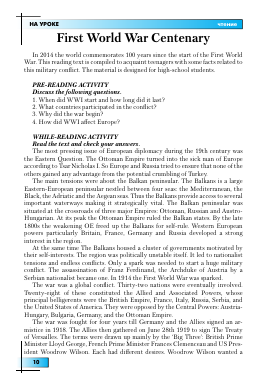HA yPOKE
First World War Centenary
In 2014 the world commemorates 100 years since the start of the First World War. This reading text is compiled to acquaint teenagers with some facts related to this military conflict. The material is designed for high-school students.
PRE-READING ACTIVITY
Discuss the following questions.
1. When did WWI start and how long did it last?
2. What countries participated in the conflict?
3. Why did the war begin?
4. How did WWI affect Europe?
WHILE-READING ACTIVITY
Read the text and check your answers.
The most pressing issue of European diplomacy during the 19th century was the Eastern Question. The Ottoman Empire turned into the sick man of Europe according to Tsar Nicholas I. So Europe and Russia tried to ensure that none of the others gained any advantage from the potential crumbling of Turkey.
The main tensions were about the Balkan peninsular. The Balkans is a large Eastern-European peninsular nestled between four seas: the Mediterranean, the Black, the Adriatic and the Aegean seas. Thus the Balkans provide access to several important waterways making it strategically vital. The Balkan peninsular was situated at the crossroads of three major Empires: Ottoman, Russian and Austro-Hungarian. At its peak the Ottoman Empire ruled the Balkan states. By the late 1800s the weakening OE freed up the Balkans for self-rule. Western European powers particularly Britain, France, Germany and Russia developed a strong interest in the region.
At the same time The Balkans housed a cluster of governments motivated by their self-interests. The region was politically unstable itself. It led to nationalist tensions and endless conflicts. Only a spark was needed to start a huge military conflict. The assassination of Franz Ferdinand, the Archduke of Austria by a Serbian nationalist became one. In 1914 the First World War was sparked.
The war was a global conflict. Thirty-two nations were eventually involved. Twenty-eight of these constituted the Allied and Associated Powers, whose principal belligerents were the British Empire, France, Italy, Russia, Serbia, and the United States of America. They were opposed by the Central Powers: Austria-Hungary, Bulgaria, Germany, and the Ottoman Empire.
The war was fought for four years till Germany and the Allies signed an armistice in 1918. The Allies then gathered on June 28th 1919 to sign The Treaty of Versailles. The terms were drawn up mainly by the 'Big Three': British Prime Minister Lloyd George, French Prime Minister Frances Clemenceau and US President Woodrow Wilson. Each had different desires. Woodrow Wilson wanted a
НА УРОКЕ
"fair and lasting peace" and had written a plan - the Fourteen Points - to achieve this. He wanted the armed forces of all nations reduced, not just the losers, and a League of Nations created to ensure peace. Frances Clemenceau insisted that Germany should pay dearly for the war, including being stripped of land, industry and their armed forces he also wanted heavy reparations. As for Lloyd George, while he personally agreed with Wilson, he was affected by public opinion in Britain which agreed with Clemenceau.
It was hard to reach a consensus. Britain and France imposed harsh terms on the Germans - but the United States refused to ratify them. It was supposed to ensure a lasting peace by punishing Germany and setting up a League of Nations to solve diplomatic problems. Instead it left a legacy of political and geographical difficulties which have often been blamed, sometime solely, for starting the Second World War.
The First World War redrew the map of Europe and the Middle East. Four great empires, the Romanov, the Hohenzollern, the Habsburg, and the Ottoman, were defeated and collapsed. They were replaced by a number of weak and sometimes avaricious successor states. "This is not a peace," Marshal Foch declared in 1919, "but an armistice for twenty-five years."
POST-READING ACTIVITY
Mark the statements after the text as true or false.
1. In the 19th century Turkey was getting weak.
2. The significance of the Balkans was its geographical location.
3. Politically the Balkans were united and strong.
4. More nations joined The Allies than the Central Powers.
5. The Treaty of Versailles was designed by Britian, France and Russia.
6. Britain and France didn't approve of severe sanctions against Germany.
7. WWI strengthened European Empires.
Keys: 1 T, 2 T, 3 F, 4 T, 5 F, 6 F, 7 F.
Sources:
http:// www.firstworldwar.com/
http://www.historylearningsite.co.uk/ww1.htm
http://europeanhistory.about.com/od/treatyofversailles/p/overtofvers.htm
А.М. Щичко
Сведения об авторе: Щичко Алексей Михайлович, учитель английского языка, ГБОУ СОШ 1279, Москва.
E-mail: alexey.schichko@mail.ru
Ключевые слова: the First World War, the Balkans, the Treaty of Versailles, the Allies, the Central Powers, Reading Activity.
Для дальнейшего прочтения статьи необходимо приобрести полный текст. Статьи высылаются в формате PDF на указанную при оплате почту. Время доставки составляет менее 10 минут. Стоимость одной статьи — 150 рублей.
